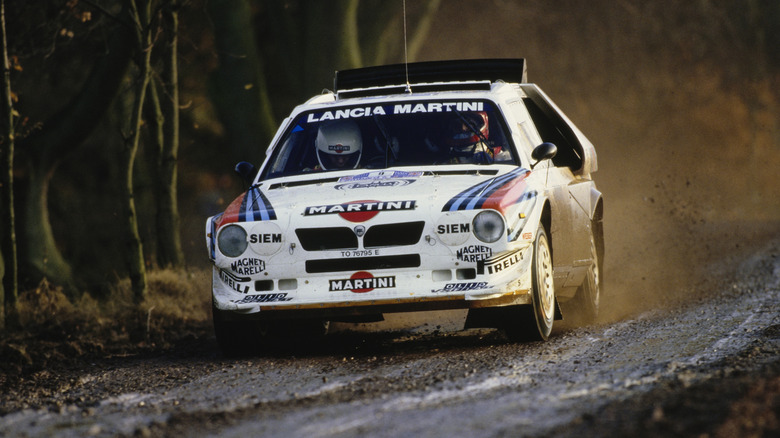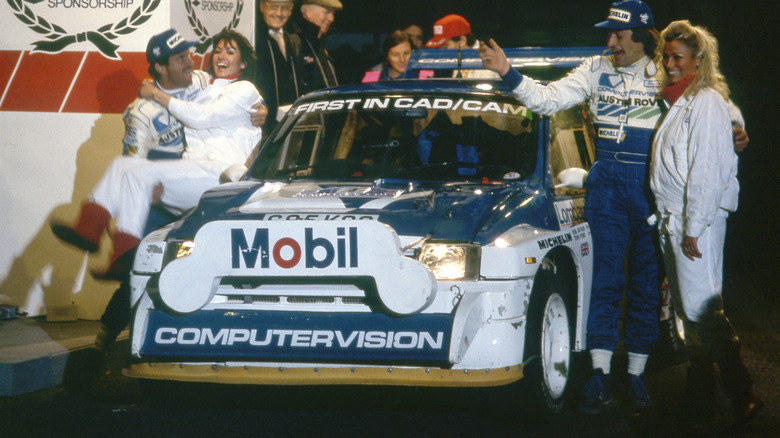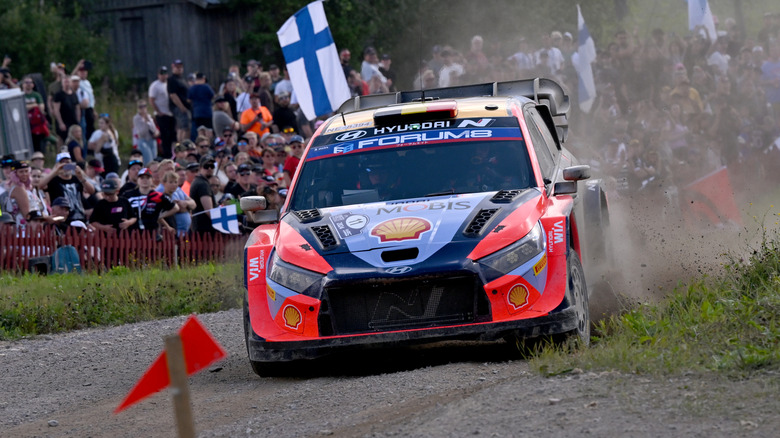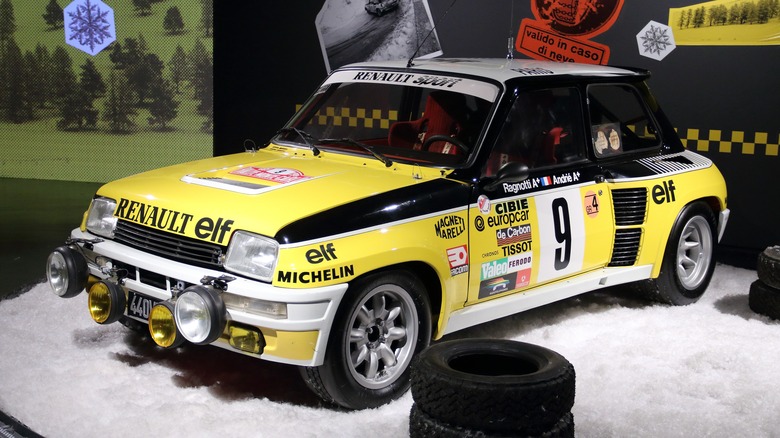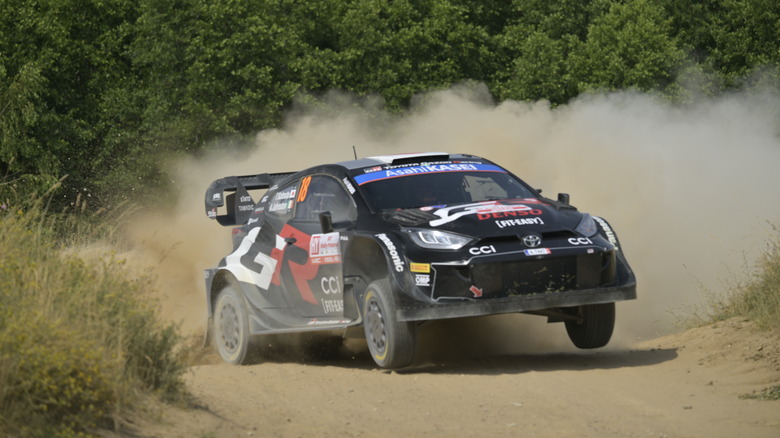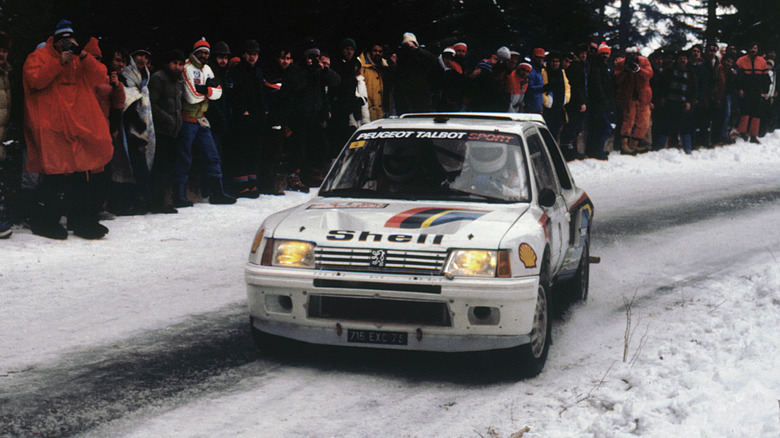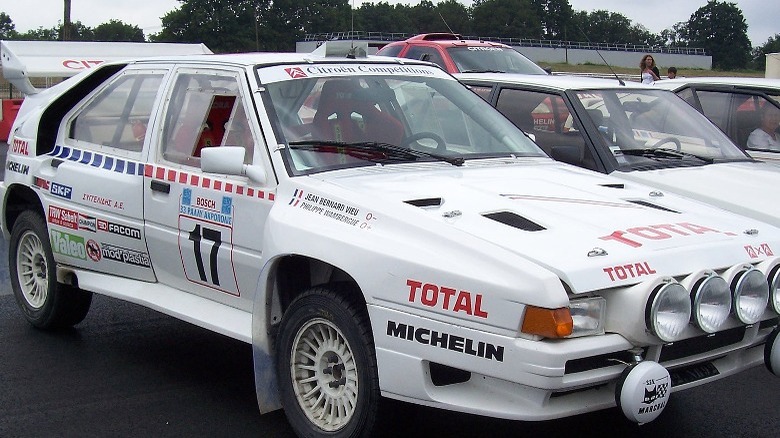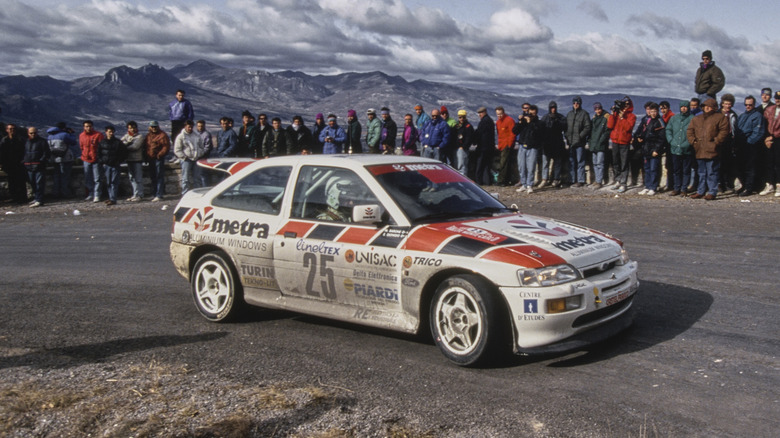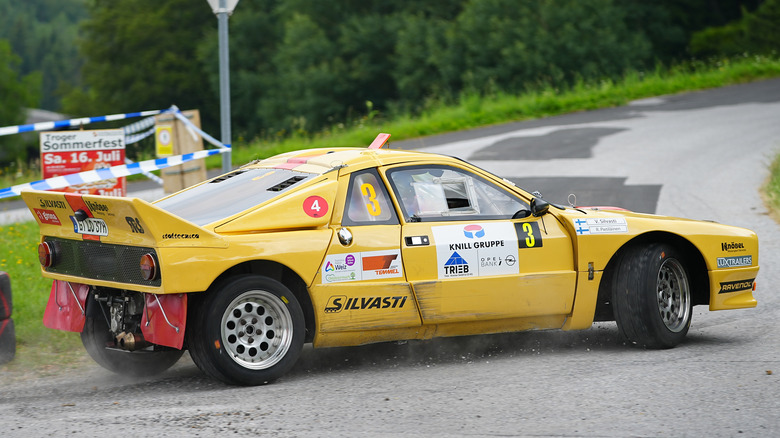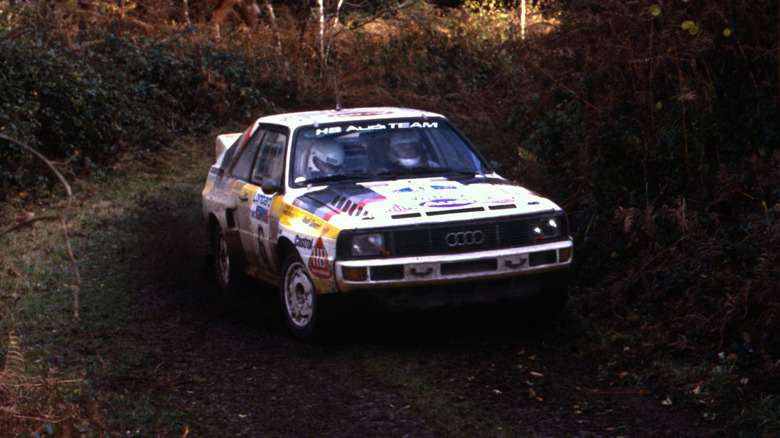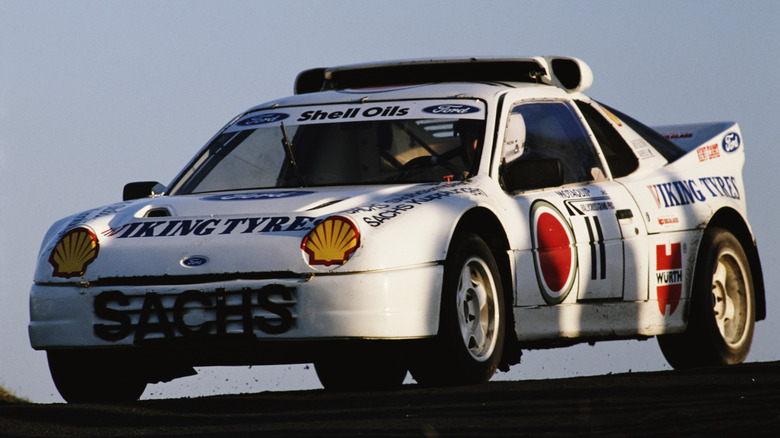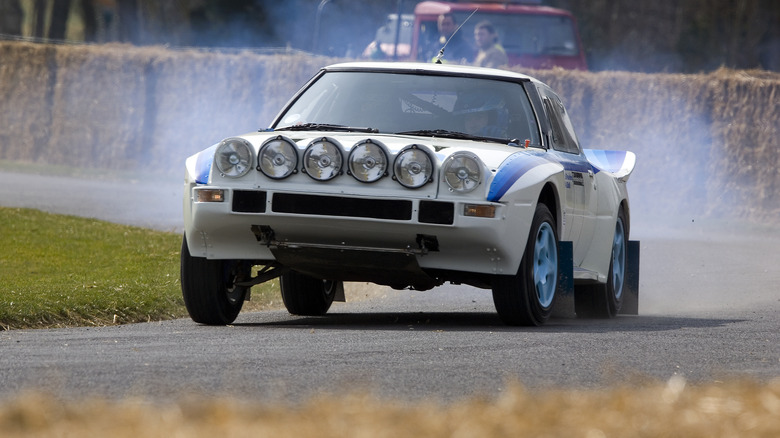The 12 Fastest Rally Cars Of All Time
Whether it's the IndyCar series or the hypercars of the World Endurance Championship, the most popular forms of racing often see cars that can travel up to and even in excess of 200 mph. But that isn't true of rally cars in the World Rally Championship. In fact, vehicles competing in the WRC are not as speedy as their counterparts in other series. So while the fastest F1 cars in the history of the sport might flash by in the blink of an eye, rally cars are easier to track.
That doesn't mean that rally cars are slow. They'll still reach top speeds well over 100 mph, but simply don't travel as fast as other racing cars. There's several reasons for this, although the main factor is the very nature of rallying. Unlike other series that race on purpose built circuits, rally events take place on roads that twist and turn with hazards such as trees and ditches situated just off the track. The lack of long straights and the constant need to change direction means that rally cars are built for handling and acceleration above everything else.
Going at what might be considered walking pace in other series when you are just inches away from all sorts of dangers is still terrifying, especially when you consider that speed could still be more than 100 mph. Below are the fastest rally cars that have ever raced, certainly leading to a raised heartbeat of anyone inside the cockpit.
MG Metro 6R4 (120 mph)
The MG Metro 6R4, named after the fact that it had a six cylinder engine and four-wheel-drive, was a rally car that competed in the Group B competition. Developed during the early 1980s, the rally car was purpose-built for racing with help from the Williams Formula 1 team, an outfit that found plenty of success during that period. When it entered the field it was something of an underdog, with the British-made car going up against established rally legends like the Audi Quattro Sport and the Peugeot 205 T16.
Later known as the Mighty Metro, it had a distinctive-sounding engine in Group B rallying. That's because it was equipped with a naturally aspirated 2997cc V6 engine, while the other cars in the class used smaller capacity forced induction engines. The novel approach was an attempt to combat turbo lag associated with the more common engine and allow for better, more consistent acceleration. MG based the power unit on the already existing Rover V8, cutting out two cylinders and making some other modifications so it was suitable for racing.
The end result was an engine with around 400 horsepower, a lot of energy for what is a small rally car. Depending on how it was geared for each stage, the MG Metro 6R4 could go from 0 to 60 mph in as little as three seconds and reach a top speed of 120 mph.
Hyundai i20 N Rally1 (124 mph)
Following the success of the highly competitive Hyundai i20 Coupe WRC, which established itself as one of the best rally cars based on race wins between 2017 and 2021, the Hyundai i20 N Rally1 is part of the current generation of Rally1 class in the World Rally Championship. Taking its basic shape and specifications from the Hyundai i20 N production car, it is a major upgrade with more than double the amount of horsepower available and an extra 150 NM of torque available. It has a variety of aerodynamic parts that help keep the engine cool and allow it to gain extra downforce on high speed runs
Like all of the other Rally1 cars competing today, the Hyundai i20 N Rally1 is equipped with a hybrid power unit. This system is made up of a direct injection turbocharged unit that produces 380 horsepower from the internal combustion engine and an additional 134 horsepower from the electric motor. That ultimately provides enough energy to get the modern rally car up to 124 mph. This is pretty much the limit of all cars in the current series given the strict regulations around engine power and speeds, although the Hyundai entry appears to be at least a few miles per hour faster than its rivals.
Renault 5 Turbo (124 mph)
Occasionally known as the R5 Turbo, the Renault 5 Turbo is a rally car from the 1980s that completed just before the start of the Group B era. Based on the Renault R5 production car, it came in several different varieties that competed in both the Group 3 and Group 4 rally championships, the two highest-level series at the time. Following the success of Lancia in the mid-to-late-1970s, it became clear that rally cars needed a new approach to be competitive — lightweight with the engine mounted in the middle of the car for efficient weight distribution.
An immediate success, the Renault 5 Turbo won its first race at the 1981 Monte Carlo Rally with French rallying legend Jean Ragnotti in the cockpit. It continues to prove fast and reliable in championships and only began to be outclassed when the new breed of Group B cars entered the scene. This was largely a result of the Renault car being built with rear-wheel-drive rather than four-wheel-drive.
The 1.4-liter turbocharged engine of the Renault 5 Turbo could initially only produce 160 horsepower but this rose to 350 horsepower throughout the lifetime of the vehicle. That allowed it to reach a top speed of 124 mph in its most powerful iteration.
Toyota GR Yaris Rally1 (125 mph)
Inspired by the Toyota GR Yaris production vehicle, the Toyota GR Yaris Rally1 is a Rally1 car that competes in the World Rally Championship. The vehicle uses what Toyota describes as an "in-line 4-cylinder turbo, direct injection, Hybrid Power Unit" that can produce over 500 horsepower across its internal combustion engine and electrical motor. Since its introduction at the start of the WRC technical regulation changes for the Rally1 class, the Toyota GR Yaris Rally1 has dominated, winning numerous stages and the drivers' and manufacturers' championship in 2022 and 2023. It is little wonder, then, that it was named Rally Car of the Year by Autosport.
According to official data released by the Toyota Gazoo Racing team, the Toyota GR Yaris Rally1 has a top speed of 201 kph, which is roughly equivalent to 125 mph. This puts it slightly ahead of the Hyundai i20 N Rally1, which has topped out at 124 mph in the current generation of top flight WRC racing. Of course, this speed is dependent on the gearing ratio used for each stage, so the car will not always be able to reach this speed when an event calls for a higher rate of acceleration.
Peugeot 205 T16 (132 mph)
Of all the rally cars that competed in the Group B class during the mid-'80s, the Peugeot 205 T16 is arguably the most well known and recognizable. Ask anyone to imagine a car from that era and there's a good chance that they'll picture this vehicle. There's good reason for that, with the Peugeot 205 T16 proving a highly effective racer that was almost unstoppable. In fact, the car was able to land two drivers' Championship titles in successive years from 1985 and collected more than a dozen stage wins during that time.
Despite the fact that it carried the 205 name, the rally version of the French hatchback has only superficial similarities to the standard production release. Anyone who has had a chance to see one of the 200 that were specially developed for civilian customers will notice the differences between the two models. Boasting a 347 horsepower 16-valve cylinder head turbocharged engine and a sophisticated four-wheel drive system, the car was super quick and remarkably easy to drive even with a top speed of 132 mph.
The end of the Group B class saw Peugeot depart rallying altogether in what ended up being more than a decade away from the sport, only returning in 1999 but the 205 T16 set a new standard that few other rally cars have been able to meet.
Citroen BX 4TC (134 mph)
It shouldn't come as a huge surprise that Citroen tried its hand at the Group B class in the mid-1980s. After all, the company had a reputation for innovative and unique designs, aspects that were needed in the largely unregulated series. This philosophy had led to plenty of success for the brand during the '60s and '70s, with the tram hoping to replicate that in Group B with the Citroen BX 4TC.
The car proved unreliable right from the outset and suffered from a number of mechanical issues that prevented it from being a true competitor in Group B. This included being overweight, lacking even power distribution, and a ride height and suspension that led to large amounts of understeer. A lot of these issues were a result of Citroen having limited development time and a much smaller budget than other teams such as Audi and Ford.
That's not to say that the Citroen BX 4TC wasn't fast. Powered by a 4-cylinder turbocharged engine and featuring four-wheel-drive, it could reach top speeds of 134 mph if the driver had the opportunity to put their foot down on a long straight on good road surfaces.
[Featured image by Dedeuche via Wikimedia Commons | Cropped and scaled |CC BY-SA 3.0]
Ford Escort RS Cosworth (136 mph)
Ford began work on what would become the Ford Escort RS Cosworth in the early '90s before it entered the WRC as part of the Group A class in 1993. The car went on to compete across several years and later competed in the World Rally Car series in 1997, up until Ford replaced the vehicle.with the newly launched Ford Focus RS WRC. While it was never able to win a championship, the goal of the Ford Works Rally Team, it did rack up a number of stage wins in its four-year history.
The Ford Escort RS Cosworth was something of a hybrid car, taking its basic shape from the fifth-generation Ford Escort road car but also implementing elements of an earlier rally car in the form of the Ford Sierra RS Cosworth. One of the main distinguishing features of the Ford Escort RS Cosworth was its larger rear spoiler, add much-needed down force to aid in stability on the road.
It also made use of a four cylinder 2.0-liter turbocharged engine that was rated to produce 227 horsepower officially, with the figure able to be improved with engine tuning when needed for specific stages. The car could accelerate from 0 to 60 mph in less than three seconds and, depending on how it was geared for each event, could reach a top speed of 136 mph.
Lancia Rally 037 (137 mph)
Like many of the fastest rally cars of all time, the Lancia Rally 037 was designed for the WRC's Group B competition. Designed with the help of fellow Italian racing outfit Abarth, the Lancia Rally 037 turned heads with its design and joined the World Rally Championship for the debut season of the Group B class in 1982. The following year, it proved the class of the field, winning the Constructors' title in 1983 after a number of stage wins.
The Lancia Rally 037 holds several records in rallying. It was the final car to win the championship as both a rear-wheel-drive and two-wheel-drive vehicle, every subsequent winner has been four-wheel-drive. Based on the Lancia Montecarlo, it saw extensive modifications so that it was effectively two separate components joined together.
The vehicle was powered by a 2.0-liter 4-cylinder supercharged engine that was positioned in the middle of the car for the best weight distribution. The total mass of the car was less than 1000 kg (2,204 lbs) and it could produce over 205 horsepower in its original form, enough to get the car to a top speed of 220 kph — roughly 137 mph. Just as impressive was its rate of acceleration, with the Lancia Rally 037 able to get to 60 mph from a standing start in under seven seconds.
Audi Quattro (137 mph)
The world of Group B rallying has had some incredible rally cars that were fast, agile, and incredibly powerful. The Audi Quattro was a modified version of the production car of the same name that the German manufacturer launched in the same year. It entered the World Rally Championship in 1980 and later saw several revisions as the Group B rules came into force, ensuring that it could compete against the others cars that were part of the series. The most important change brought along was the introduction of four-wheel-drive, a decision that led to rallying abandoning the two-wheel-drive model.
The Audi Quattro went on to win two drivers' championships and two constructors' championships between 1982 and 1984, proving that it was lightning quick. This was possible thanks to its 2.1-liter in-line engine with a KKK turbocharger, providing up to 197 horsepower and a top speed of 137 mph. So beloved and in demand is the Audi Quattro that it has managed to attract major interest when models have gone up for sale. In 2021, a 1988 version of the racer sold at auction for over $2.3 million to make it the most expensive rally car of all time.
Ford RS200 (139 mph)
The Ford RS200 is one of the most legendary rally cars ever made. Competing during the infamous Group B era, it was Ford's answer to the high-powered and technologically advanced cars that were also taking part. The U.S. brand had originally planned to create a rally car for the series from its Escort range, although this was later dropped as the company chose to instead build a brand new car from the ground up. The result was the history-making Ford RS200.
Featuring a four-wheel-drive system that could be customized to split the torque between the front and rear wheels to any specifications required by the team, the Ford RS200 showed plenty of promise in races despite reliability problems but was also notoriously difficult to drive. It was involved in a number of high-profile crashes, some of which proved fatal. This eventually led to the Ford RS200 being banned along with the other Group B cars.
Like many of the competitors in the Group B class, Ford chose to use a turbocharged engine in the form of a Cosworth 1.8-liter turbo four-cylinder. Thanks to some modifications over the years, it was eventually able to produce 420 horsepower and reach a top speed of 139 mph.
Mazda RX-7 Group B (140 mph)
The Group B series was dominated by a select few manufacturers. The Peugeot 205 T16, Lancia Delta S4, Ford RS200, and Audi Sport Quattro dominated the sport in the 1980s, but other contenders tried to step up. One of those came from Japan, in the form of the Mazda RX-7. The project was headed by former German rally driver Achim Warmbold and was intended to introduce Mazda's unique rotary power engines to a wider audience.
This power unit was unlike any other being used in Group B rallying. Naturally aspirated, it lacked the turbo system that had become commonplace, and also utilized a rear-wheel-drive system in an era when four-wheel-drive was the norm. That put the car at a distinct disadvantage compared to leaders, although it did find some limited success with a career-high third place at the 1985 Acropolis Rally with Ingvar Carlsson behind the wheel. This was a notable highlight during its entry in the sport between 1984 and 1986.
While the Mazda RX-7 didn't set the world alight in terms of result, it was widely admired by fans because of its stylish looks and the way it often slid sideways around corners. Thanks to the 300 horsepower from the engine, the car could get up to speeds of around 140 mph.
Lancia Delta S4 (140 mph)
The Lancia Delta S4 isn't a car that missed out on Group B rally glory. The Italian vehicle was a highly successful racer that was entered into the World Rally Championship for two years between 1985 and 1986. In fact, the car was only stopped following the abolition of the Group B class after a crash at the Tour de Corse that killed Henri Toivonen and his co-pilot Sergio Cresto. Realizing that Group B cars were excessively dangerous due to the ever-increasing power they had, organizers ended the series and put in place stricter regulations to govern how fast rally cars could go.
Before that, the Lancia Delta S4 had established itself as one of the fastest rally cars ever created. With five wins across the WRC, it had a twin-charged 1.8 liter Fiat engine that could output 550 horsepower. To help it achieve peak performance, Lancia also stripped down the weight of the car significantly, to the extent that some questioned its safety. It had a reputation for being difficult to drive and forced pilots to drive on the edge to get the best out of it.
Able to get to 60 mph in less than six seconds, the Lancia Delta S4 could reach a potential top speed of 140 mph. To meet the Group B's homologation rules, Lancia was required to manufacture 200 road versions of the car — although less than 100 of the Stradale model was ultimately produced by the Italian company.
